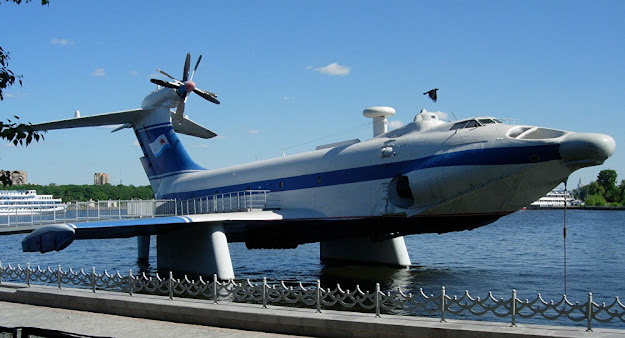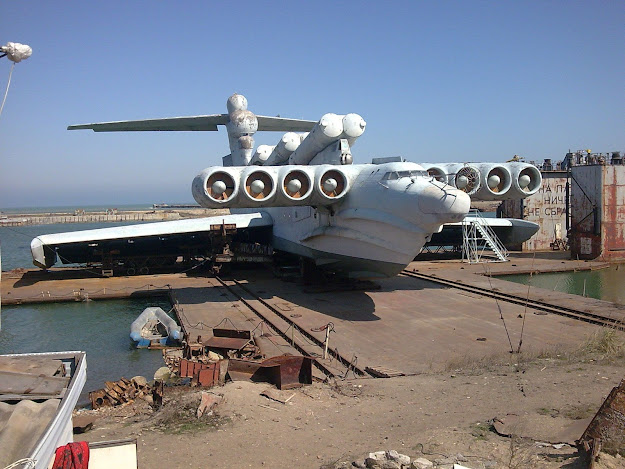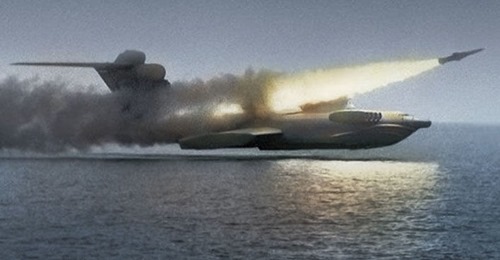Lun (schermoplano)
Il Lun (colomba in russo) era uno schermoplano di progetto e costruzione sovietica. In Russia è identificato, come le navi, con un numero di progetto: in questo caso, è il Progetto 903. Sviluppato per l'impiego antisommergibile, entrò in servizio a partire dal 1987. Fu ritirato dal servizio nel 1992, quando il programma venne definitivamente cancellato.
Sviluppo
La progettazione del Lun venne portata avanti dall'Ufficio Centrale di Progettazione TsKB po SPK R.E.Alekseyev, che si basò ampiamente sulle esperienze condotte sia sui KM sia sugli A-90 Orlyonok. La fase costruttiva fu curata dal cantiere navale Volga, che completò il primo (ed unico) esemplare nel 1987. Un altro esemplare rimase incompiuto.
Questo mezzo, tuttavia, era afflitto, come i suoi predecessori, da diversi problemi, primo tra tutti quello della stabilità e del controllo. Inoltre, avevano una manovrabilità piuttosto scarsa ed erano difficili da pilotare. Per questa ragione, nonostante fosse entrato ufficialmente in servizio con la Marina sovietica nel 1989, non fu mai schierato con le altre unità combattenti.
Tecnica
Il progetto aveva, ovviamente, numerosi punti in comune con gli schermoplani costruiti in precedenza, in particolare i KM. Tuttavia, presentava numerose differenze. Infatti, oltre ad essere decisamente più piccolo, aveva anche un peso inferiore.
La propulsione era assicurata da otto reattori Kuznetsov NK-87 da 13.000 chilogrammi di spinta l'uno, che erano sistemati, come nei KM, in due blocchi di quattro su un asse posto sopra la fusoliera. Al contrario dell'enorme predecessore, si era deciso di rinunciare ai due motori di coda. L'esatta velocità non è conosciuta, ma era comunque compresa tra i 450 ed i 550 km/h.
L'autonomia era di circa 3.000 km, e poteva rimanere in mare per ben cinque giorni.
Il radar, che era piuttosto avanzato, era sistemato nel muso.
L'armamento era composto da sei impianti lanciamissili per SS-N-22 Sunburn, sistemati sul dorso della fusoliera in tre coppie.
Utilizzo
Il Lun entrò in servizio nella Flotta del Mar Nero nel 1989 con il nome di MD-160. Le sue caratteristiche lo rendevano idoneo per attaccare in modo rapido ed imprevedibile i gruppi navali nemici, ma, come detto, non venne mai schierato con le unità combattenti probabilmente a causa dei suoi problemi tecnici. Fu ritirato dal servizio nel 1992, quando il programma venne cancellato per mancanza di fondi.
Oggi risulta inquadrato nella Flottiglia del Caspio in attesa di revisione. Formalmente, dovrebbe essere a carico dell'11º Gruppo Aereo Indipendente.
È parcheggiato presso il porto militare della città di Kaspijsk, sul mar Caspio (Coordinate esatte: 42°53′04″N 47°39′22″E).
Lo Spasatel
Nel 1989, in seguito al tragico incidente del sottomarino K-278 Komsomolec, che provocò la morte di 42 marinai, venne presa la decisione di equipaggiare un secondo Lun, che all'epoca era in costruzione, come schermoplano per operazioni di ricerca e salvataggio degli equipaggi delle unità navali in difficoltà. Questo mezzo, chiamato Spasatel, avrebbe dovuto essere progettualmente piuttosto simile al Lun, anche se con alcune differenze. Nello specifico, avrebbe avuto sei reattori invece di otto, e sarebbe stato equipaggiato con un'attrezzatura specifica per le operazioni di salvataggio.
Lo scopo era quello di avere un mezzo di trasporto capace di arrivare con estrema rapidità in mezzo all'oceano e di raggiungere, con altrettanta rapidità, la costa. In teoria avrebbe dovuto essere in grado di portare in salvo da 150 a 500 persone.
L'allestimento dello Spasatel proseguì fino al 1992, quando il programma venne cancellato a causa del collasso dell'URSS. Comunque, i lavori erano in gran parte ultimati.
Ekranoplano
L'ekranoplano è una classe di aerodine che si possono considerare come l'anello di congiunzione tra l'idrovolante e l'aliscafo.
Questo tipo di aeromobile si muove volando a pochi metri dalla superficie (in genere sull'acqua), sfruttando per il sostentamento l'effetto suolo. Sostanzialmente una volta che il mezzo ha accelerato si sviluppa al di sotto di esso quello che può essere definito come un cuscino d'aria dinamico. Sono anche noti come WIG (Wing In Ground effect), Ala a effetto suolo o GEV (Ground Effect Vehicle) Veicolo a effetto suolo, quest'ultimo il termine più generico.
Origine del termine
Il termine ekranoplano è l'adattamento dal russo del termine экраноплан, ekranoplan, letteralmente "schermoplano". Infatti questa particolare tipologia di velivoli, che a prima vista sembrano grandi idrovolanti caratterizzati da ali tozze e da giganteschi piani di coda, venne sviluppata dai sovietici a partire dagli anni cinquanta. Il loro inventore fu l'ingegnere navale sovietico, Alexeev Rostislav Evgenievich. Allo sviluppo contribuì anche un italiano di Fiume, Roberto Bartini, emigrato nell'Unione Sovietica nel 1923 per motivi politici, che sviluppò il Bartini-Beriev VVA-14, idrovolante VTOL che combinava le caratterische degli ekranoplani.
Parallelamente negli Stati Uniti, l'ingegnere aeronautico tedesco Alexander Martin Lippisch, iniziò a lavorare sullo stesso concetto, partendo però dall'aria e non dall'acqua, come il suo omologo sovietico. Questi sviluppò una serie di velivoli, nettamente più piccoli, che sfruttavano lo stesso principio, e che vennero definiti WIG (Wing In Ground effect), Ala a effetto suolo.
A Roberto Bartini, Alexeev Rostislav Evgenievich e Alexander Martin Lippisch, si aggiunse anche il tedesco Gunther Jörg.
Il termine WIG e il termine ekranoplano sono comunque spesso usati come sinonimi. Oggi si è affiancato ai due termini l'acronimo GEV (Ground Effect Vehicle), Veicolo a effetto suolo, per indicare un qualunque mezzo che sfrutti l'effetto suolo per migliorare la sua efficienza. Esistono poche ditte che producono piccole versioni di WIG/Ekranoplani, al più capaci di 10 passeggeri, ma c'è comunque sempre un certo interesse all'uso dell'effetto suolo per migliorare l'efficienza di aerei o imbarcazioni. Se un ekranoplano, nelle intenzioni degli sviluppatori, combina le qualità di velocità degli aerei con la capacità di trasporto delle navi, una tappa intermedia può essere costituita da aerei che sfruttano l'effetto suolo nel volo a bassa quota, o in catamarani/trimarani che godono in movimento di una certa portanza, grazie all'ausilio di superfici portanti. Tutti questi "ibridi" vengono classificati come GEV.
Sviluppi: il programma KM
Il programma KM venne portato avanti dall'Unione Sovietica a partire dal 1963. Il primo mezzo di questo tipo, il KM-1 ("Caspian Sea Monster", Mostro Marino del Mar Caspio, soprannome datogli dall'intelligence statunitense), "volò" per la prima volta nel 1966. Questo fu la base sulla quale venne sviluppato il primo schermoplano appositamente progettato per la produzione in serie, l'A-90 Orlyonok. Questo, costruito in soli 3/4 esemplari, entrò effettivamente in servizio con la Marina Sovietica.
Un'ulteriore versione, il Lun, venne costruito a partire dal 1987. Si trattava di uno schermoplano armato con sei missili antinave, posti sul dorso della fusoliera. Ne venne costruito un solo esemplare, con un altro mai completato.
Tutto il programma venne cancellato nel 1992, in seguito al crollo dell'URSS e alla conseguente crisi economica.
Fonti di stampa del 2008 hanno riportato notizie circa l'intenzione di riprendere lo sviluppo della tecnologia sia negli Stati Uniti (Boeing, progetto "Pelican") sia in Russia e in Germania.
ENGLISH
Mon (screenplane)
The Lun (dove in Russian) was a Soviet design and construction shieldplane. In Russia it is identified, like ships, with a project number: in this case, it is Project 903. Developed for antisubmarine use, it entered into service in 1987. It was withdrawn from service in 1992, when the programme was definitively cancelled.
Development
The design of the Lun was carried out by TsKB's Central Design Office SPK R.E.Alekseyev, which relied extensively on the experiences of both the KM and the A-90 Orlyonok. The construction phase was supervised by the Volga shipyard, which completed the first (and only) model in 1987. Another example remained unfinished.
This vessel, however, was plagued, like its predecessors, by several problems, first of all stability and control. Moreover, they had a rather poor manoeuvrability and were difficult to steer. For this reason, although it officially entered into service with the Soviet Navy in 1989, it was never deployed with the other fighting units.
Technique
The project had, of course, numerous points in common with the previously built fencers, in particular the KMs. However, it had many differences. In fact, apart from being much smaller, it also had a lower weight.
Propulsion was provided by eight Kuznetsov NK-87 reactors with a thrust of 13,000 kilograms each, which were housed, as in the KMs, in two blocks of four on an axis above the fuselage. In contrast to the huge predecessor, it was decided to give up the two tail engines. The exact speed is unknown, but it was still between 450 and 550 km/h.
The autonomy was about 3,000 km, and it could stay at sea for five days.
The radar, which was quite advanced, was set in the nose.
The armament was composed of six missile launchers for SS-N-22 Sunburn, placed on the back of the fuselage in three pairs.
Use
Lun entered service in the Black Sea Fleet in 1989 under the name MD-160. Its characteristics made it suitable to quickly and unpredictably attack enemy naval groups, but, as said, it was never deployed with the fighting units probably because of its technical problems. It was withdrawn from service in 1992, when the programme was cancelled due to lack of funds.
Today it is part of the Caspian Flotilla awaiting revision. Formally, it should be borne by the 11th Independent Air Group.
It is parked at the military port of the city of Kaspijsk on the Caspian Sea (exact coordinates: 42°53′04″N 47°39′22″E).
The Spasatel
In 1989, following the tragic accident of the submarine K-278 Komsomolec, which resulted in the death of 42 sailors, the decision was taken to equip a second Lun, which was under construction at the time, as a search and rescue vessel for the crews of ships in distress. This vessel, called Spasatel, should have been rather similar in design to the Lun, although with some differences. Specifically, it would have had six reactors instead of eight, and would have been equipped with specific equipment for rescue operations.
The aim was to have a means of transport capable of arriving extremely quickly in the middle of the ocean and reaching the coast just as quickly. In theory it should have been able to carry between 150 and 500 people to safety.
The construction of the Spasatel continued until 1992, when the programme was cancelled due to the collapse of the USSR. However, the work was largely completed.
Ekranoplano
The ekranoplane is a class of aerodynamics that can be considered as the link between the seaplane and the hydrofoil.
This type of aircraft moves by flying a few metres above the surface (usually over water), using the ground effect for sustenance. Basically, once the aircraft has accelerated, what can be defined as a dynamic air cushion develops below it. They are also known as WIG (Wing In Ground Effect), Wing In Ground Effect Vehicle or GEV (Ground Effect Vehicle), the latter being the more generic term.
Origin of the term
The term ekranoplane is an adaptation from Russian of the term экраноплан, ekranoplan, literally "fencing plane". In fact, this particular type of aircraft, which at first glance look like large seaplanes characterised by stumpy wings and gigantic tail planes, was developed by the Soviets starting from the Fifties. Their inventor was the Soviet naval engineer, Alexeev Rostislav Evgenievich. An Italian from Rijeka, Roberto Bartini, who emigrated to the Soviet Union in 1923 for political reasons, also contributed to the development. He developed the Bartini-Beriev VVA-14, a VTOL seaplane that combined the characteristics of ekranoplanes.
At the same time in the United States, the German aeronautical engineer Alexander Martin Lippisch, started working on the same concept, but starting from air and not water, like his Soviet counterpart. He developed a series of much smaller aircraft using the same principle, which were called WIG (Wing In Ground effect).
Roberto Bartini, Alexeev Rostislav Evgenievich and Alexander Martin Lippisch were joined by the German Gunther Jörg.
The term WIG and the term ekranoplane are however often used as synonyms. Today the two terms have been joined by the acronym GEV (Ground Effect Vehicle) to indicate any vehicle that uses the ground effect to improve its efficiency. There are few companies that produce small versions of WIG/Ekranoplanes, at most capable of 10 passengers, but there is always a certain interest in using the ground effect to improve the efficiency of aircraft or boats. If an ekranoplane, in the developers' intentions, combines the speed qualities of aircraft with the transport capacity of ships, an intermediate stage may be aircraft that exploit the ground effect in low altitude flight, or in catamarans/trimarans that enjoy a certain lift on the move, thanks to the use of load-bearing surfaces. All these "hybrids" are classified as GEV.
Developments: the KM programme
The KM programme has been carried out by the Soviet Union since 1963. The first vehicle of this type, the KM-1 ("Caspian Sea Monster", nicknamed by US intelligence), "flew" for the first time in 1966. This was the basis on which the first specially designed fencing plane for mass production, the A-90 Orlyonok, was developed. This, built in only 3/4 units, actually went into service with the Soviet Navy.
A further version, the Lun, was built in 1987. It was a fencing plane armed with six anti-ship missiles on the back of the fuselage. Only one specimen was built, with another one never completed.
The entire programme was cancelled in 1992, following the collapse of the USSR and the ensuing economic crisis.
Press sources in 2008 reported reports of plans to resume technology development in the US (Boeing, Pelican project) as well as in Russia and Germany.
(Web, Google, Wikipedia, You Tube)

















































Nessun commento:
Posta un commento
Nota. Solo i membri di questo blog possono postare un commento.